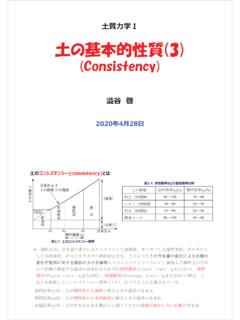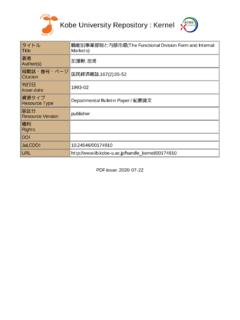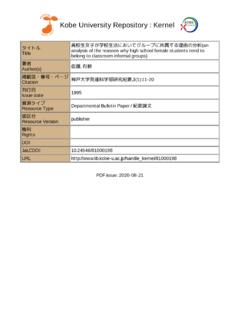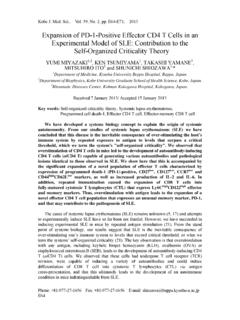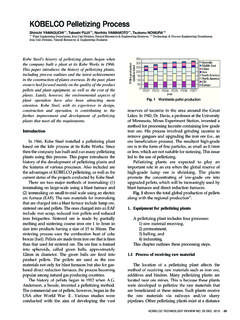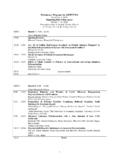Transcription of Infrastructure Development for the Economic …
1 GSICS Working Paper Series Infrastructure Development for the Economic Development in Developing Countries: Lessons from Korea and Japan Byoungki KIM. No. 11. November 2006. Graduate School of International Cooperation Studies Kobe University Infrastructure Development for the Economic Development in Developing Countries: Lessons from Korea and Japan Byoungki KIM . Abstract Infrastructure is indispensable to achieve the main Development targets in developing countries, such as urbanization, industrialization, export promotion, equitable income distribution, and sustainable Economic Development . Late developing countries can benefit from previous Development experience provided they choose the right model1. However, the relationship between Infrastructure and Economic growth is still frequently debated. This paper will examine the experience of Korea and Japan in Infrastructure Development for Economic growth to acquire some valuable lessons that Infrastructure Development contributes to Economic Development in developing countries.
2 1. Introduction The lack of Infrastructure is hindering the Economic growth in many developing countries2. Infrastructure investment has the effects of contributing to increase the productivity and it is expected to contribute to future Economic growth in developing countries where Infrastructure is still insufficient. Therefore, Infrastructure Development is one of the most integral parts of the public policies in developing countries. Supporting Infrastructure Development in developing countries by advanced countries is extremely important field. This can be inferred from the fact that many international organizations such as World Bank and OECD are actively promoting the improvement of Infrastructure by providing various support programs to developing countries. However, the precise relationship between Infrastructure and Economic growth is still frequently debated.
3 Good Infrastructure helps to raise productivity and lower costs in the directly productive activities of the economy, but it has to be expanded fast enough to meet the demand for Infrastructure in the early stage of Development . Construction expense for Infrastructure such as energy and transportation sector is enormous and construction period is also long. Prediction of demand pattern and investment allocation, which are the key factors of Infrastructure Development planning, must be based on a long term Economic Development trend and land use planning, which predicts the country's temporal and spatial demographics and Economic structure. Postwar, Japan and Korea had received a large amount of concessional loans and grants from the US. and international organizations for rebuilding Economic infrastructures . These valuable experiences give * Graduate School of International Cooperation Studies, Kobe University e-mail: 1.
4 Il Sakong (1993) emphasized that the late developers can draw valuable lessons from the Korea's experience in developing its Infrastructure for the Economic Development . 2. World Bank (1994) estimated the relationship between Infrastructure and Economic growth in many case studies including China and India. 1. them a comparative advantage in providing cooperation of Infrastructure Development to developing countries. These days Japan and Korea are providing a great share of ODA for the Infrastructure Development in developing countries. Construction of power stations, paved roads, bridges, and telecommunication are main supporting field of both countries. The large share of support for the Economic Infrastructure by Korea is frequently criticized. This paper will examine Korea's experience in developing its Infrastructure for the Economic growth and its role in Development cooperation to developing countries.
5 First, the patterns of Infrastructure demand in the electricity, transportation, and communication sectors which are key infrastructures in national Development will be analyzed at each phase of Economic Development from the 1910s to 1990s. Second, public investment for Infrastructure Development in Korea and Japan will be analyzed for the same period. Third, the relationship between Infrastructure Development and Economic growth in Korea will be examined with reviewing Japan's experience. In addition, public investment to Infrastructure and income distribution will be discussed. Finally, strategic viewpoints on future cooperation for Infrastructure Development to developing countries will be discussed. 2. Empirical studies on Infrastructure Development Definition of Infrastructure Infrastructure is referred to as social overhead capital by many Development economists.
6 Hirshman (1958) provided appropriate definition of Infrastructure for the discussion3. Social overhead capital encompasses activities that share technical features such as economies of scale and Economic features like spillovers from users to non-users. The social capital acts as a priming to expand private sector investment, and in contrast, social capital becomes relatively lacking along with the expansion of private capital and productive activities. When that happens, the private sector's indirect production costs gradually increase and private sector capital input declines. At this stage, demand for social capital investment recurs and such investment is expended. Social overhead capital contributes to enhancing productivity and assists in the realization of the potential ability of human capital, and creates situations in which that potential can fully function.
7 It also contributes directly and indirectly to improving the safety and quality of people's lives. Within the scope of Infrastructure , electric power, ports, roads, and telecommunications are often used as the services and intermediate goods that are essential for the productive processes of private sector. In this paper, Infrastructure will be referred to as social overhead capital and electricity, transportation, and communication will be regarded as Economic Infrastructure . 3. Hirshman proposed the concept of social overhead capital, which supplements direct productive capital, and commented the relationship between direct productive capital of the private sector and social overhead capital, which is mainly built by public bodies. Definition of Infrastructure is also discussed in detail in Yoshida (2000). 2. Empirical studies on Infrastructure Development and Economic growth Ruttan (1989) discussed the reason why advanced countries provide ODA to developing countries.
8 He asserted that there are two arguments one is based on the Economic and strategic self-interest of the donor country. The second one is based on the ethical or moral responsibility of the residents of wealthy countries toward the residents of poor countries. Many studies provide surveys of why Infrastructure is important in Economic Development and evaluate recent empirical results estimating the contribution of public capital and Infrastructure to Economic growth. They suggest that the impact of Infrastructure investment on Economic growth represents high rate of return. Easterly and Rebelo (1993) verified whether or not changes in the level of various policy variables permanently increased the Economic growth rate, and clarified whether or not investments related to information and telecommunications raised the Economic growth rate. They found that public Infrastructure investment is a large fraction of both total and public investment, and Infrastructure in transportation and communication is consistently correlated with Economic growth.
9 The rate of return in these sectors is 63%. and elasticity of change in output with respect to a 1% change in the level of Infrastructure is World Bank (1994) emphasized that there is a close relationship between Infrastructure and Economic growth. This is seen in the lack of Infrastructure Development hindering the Economic growth in China and in many case studies, such as those on the direct and indirect Economic impact of Infrastructure in farming sector in India. In the case of China, the coverage of intercity transport networks is one of the thinnest in the world. China's transportation investments amounted to only of GNP annually during 1981-90, a period of rapid growth in transportation demand. Since the onset of China's open door policy in 1979, Economic growth averaging 9% a year has resulted in an unprecedented expansion in intercity traffic with growth averaging 8% a year for freight and 12% a year for passengers.
10 This traffic growth has imposed tremendous strains on the transportation Infrastructure , as manifested by the growth of bottlenecks in the railway network, the severe rationing of transportation capacity on railway lines, and the poor quality of service experienced by shippers and passengers. A conservative estimate is that the annual Economic costs of not having adequate transportation Infrastructure in China during the past several years amount to about 1% of China's GNP. This relationship is also shown in cross- section data analyses that indicate positive relationship between the levels of Infrastructure , such as the Development of electricity, telecommunications, roads and other facilities and that of economy. Yoshida (2000) presented a positive analysis from various angles of the correlations between Economic growth and the Infrastructure in Japan, such as the energy, electricity, and transportation sectors over the last century in order to derive lessons that can be useful to developing countries.



